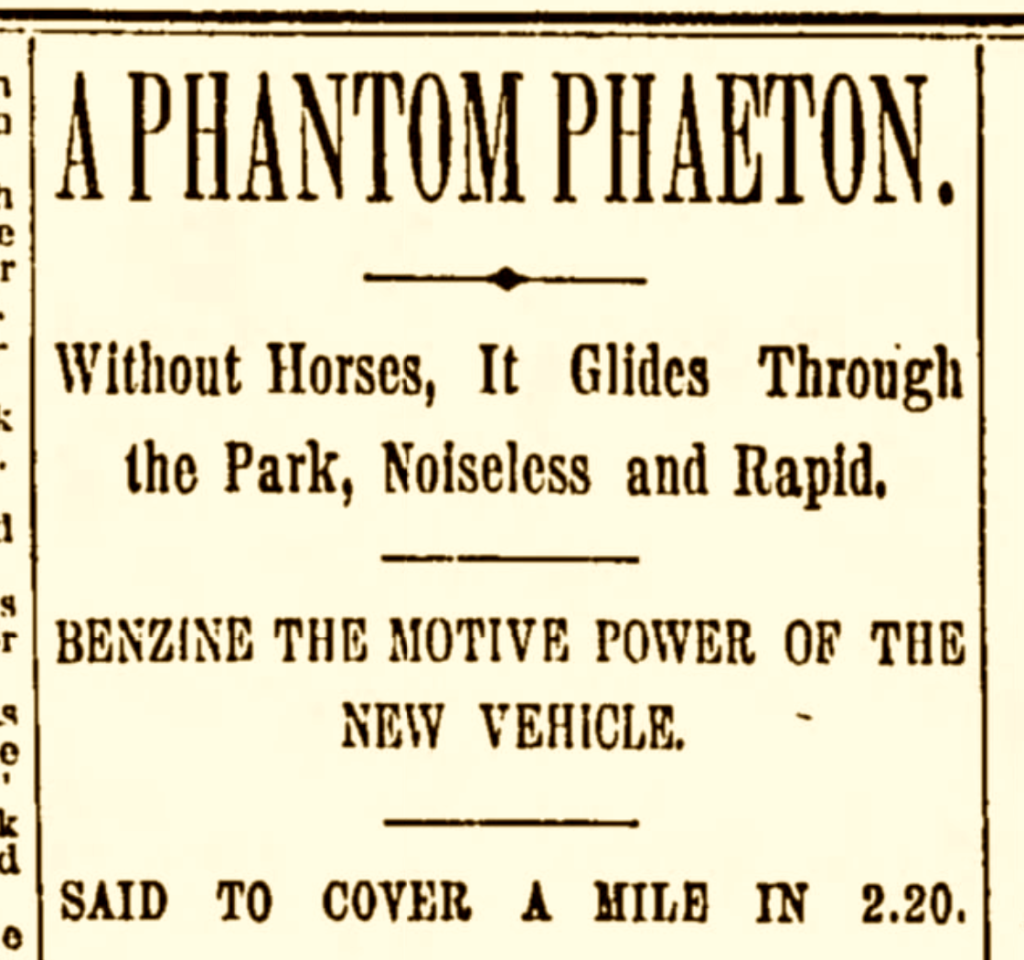Tuesday, June 4, 2024 – TAKING A RIDE IN CENTRAL PARK


TUESDAY, JUNE 4, 2024
ISSUE #1248
The mystery of the
“phantom phaeton”
driving in
Central Park
and
astonishing crowds in 1893
Ephemeral New York

On a Saturday in late November 1893, The World ran an article about what headline writers dubbed the “phantom phaeton.”
In the late 19th century city, everyone would have known what a phaeton was—a horse-drawn carriage with short sides and oversize wheels. Wealthier New Yorkers tended to be the ones riding and driving this light, sporty vehicle.
But the phantom phaeton The World wrote about had no horses pulling it, and its driver went unidentified. “For the past week a mysterious, self-propelling carriage has astonished the afternoon throng in Central Park,” the article stated.

“It threads its way easily among the crush of equipages on the East Drive, turning, winding in and out, and checking or increasing speed as readily as any of the vehicles drawn by horses.”
After cruising through Central Park following a 3:30 p.m. stop in front of the Plaza Hotel, the phantom phaeton would then turn west and end up on Riverside Drive. “It moves noiselessly and without smoke, gliding along without any locomotive-like clankings or puffings,” wrote The World.

The phantom phaeton wasn’t New York City’s first automobile; in 1885 a manufacturer on West 53rd Street was making a type of motor car called the Allen.
But it might have been one of the first to make regular appearances along the crowded drives of Central Park, where people were stunned by what The World called “a novelty” that could “cover a mile” in two minutes.

| The World addressed the mystery: where did this “motor wagon” with rubber tires come from, and how does it work? A reporter tracked the phaeton to Jones’ Wood, a tract of land between Lenox Hill and the East River that was once considered as the ideal spot for Gotham’s first public park.A specific owner was never identified, but the reporter wrote that it was “of a type said to be popular in Germany….The motor is driven by gas which is generated as needed by ordinary benzine, which is carried in a closed copper tank under the seat….The speed is regulated at will and the steering done by the valves before the seat.”What the article doesn’t say is what we know now: the era of the automobile was beginning. In 1899, the city held its first “automobile parade,” featuring electric and steam-powered cars. (Video below) |
| To see movie go to: |
A year later, Madison Square Garden became the site of the first National Automobile Show (fourth image)—the same year New York State counted 500 registered privately owned cars, and “automobile stages” began ferrying passengers on Fifth Avenue.
By 1910, cars were a regular part of the streetscape, and in 1920 the first traffic signal went up on Fifth Avenue and 42nd Street. (A little too late for Henry Bliss, the first New Yorker to be killed by a car; in 1899 he was struck by an electric taxi at Central Park West and 74th Street.)
The World article ended by asking a coachman who worked at the West Side stable of John D. Crimmins what he thought of the phantom phaeton, which cruised past the stable on its daily trips across Manhattan.

The coachman said automobiles should be a success for country driving. “‘But for city use,’ he added, ‘no machine can take the place of a skilled hand on the box.'”
“But then, people scoffed at Robert Fulton when he began,” concluded The World.

PHOTO OF THE DAY
This food cart sits virtually rent-free at the subway 24/7, taking away business from our island businesses that pay high rents, taxes, and insurance. They struggle while the cart sits comfortably at the prime subway stop, attracting mostly tourists. It’s time to stand up for our island merchants who are losing out to this freeloader.

CREDITS:
EPHEMERAL NEW YORK
[Top photo: driving past the Hotel Empire on Broadway and 62nd Street; MCNY, 1898, X2010.11.8213; second image: The World, 1893; third image: 1905, MCNY, X2010.34.1657; fourth image via Wired; fifth image (video): Library of Congress; sixth image: NYPL Digital Collections]
All image are copyrighted (c) Roosevelt Island Historical Society unless otherwise indicated
THIS PUBLICATION FUNDED BY DISCRETIONARY FUNDS FROM CITY COUNCIL MEMBER JULIE MENIN & ROOSEVELT ISLAND OPERATING CORPORATION PUBLIC PURPOSE FUNDS.


Copyright © 2024 Roosevelt Island Historical Society, All rights reserved.Our mailing address is:
rooseveltislandhistory@gmail.com

Leave a comment